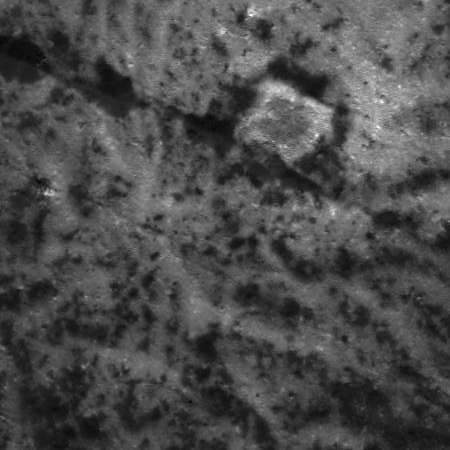Close-up of bright spot in Occator Crater
Cool image time! The Dawn science team today released some new images taken by the spacecraft in its final tight orbit around the dwarf planet Ceres. The image on the right is a cropped section of the full image. It shows some interesting details of part of one of the two bright spots in Occator Crater, dubbed Vinalia Facula, and was taken from a distance of 36 miles.
Other images show small bright spots in another small crater, fractures and interesting patterns in the floor of Occator crater, a dome in Occator Crater suggestive of underground processes pushing up, and other close-ups of its crater walls.
While all of these features are reminiscent of geology on Earth, none are really the same. Ceres’ light gravity and harsh environment, plus its history in the asteroid belt, requires alien processes that only hint at similarities to what we see on Earth.
On Christmas Eve 1968 three Americans became the first humans to visit another world. What they did to celebrate was unexpected and profound, and will be remembered throughout all human history. Genesis: the Story of Apollo 8, Robert Zimmerman's classic history of humanity's first journey to another world, tells that story, and it is now available as both an ebook and an audiobook, both with a foreword by Valerie Anders and a new introduction by Robert Zimmerman.
The ebook is available everywhere for $5.99 (before discount) at amazon, or direct from my ebook publisher, ebookit. If you buy it from ebookit you don't support the big tech companies and the author gets a bigger cut much sooner.
The audiobook is also available at all these vendors, and is also free with a 30-day trial membership to Audible.
"Not simply about one mission, [Genesis] is also the history of America's quest for the moon... Zimmerman has done a masterful job of tying disparate events together into a solid account of one of America's greatest human triumphs."--San Antonio Express-News
Cool image time! The Dawn science team today released some new images taken by the spacecraft in its final tight orbit around the dwarf planet Ceres. The image on the right is a cropped section of the full image. It shows some interesting details of part of one of the two bright spots in Occator Crater, dubbed Vinalia Facula, and was taken from a distance of 36 miles.
Other images show small bright spots in another small crater, fractures and interesting patterns in the floor of Occator crater, a dome in Occator Crater suggestive of underground processes pushing up, and other close-ups of its crater walls.
While all of these features are reminiscent of geology on Earth, none are really the same. Ceres’ light gravity and harsh environment, plus its history in the asteroid belt, requires alien processes that only hint at similarities to what we see on Earth.
On Christmas Eve 1968 three Americans became the first humans to visit another world. What they did to celebrate was unexpected and profound, and will be remembered throughout all human history. Genesis: the Story of Apollo 8, Robert Zimmerman's classic history of humanity's first journey to another world, tells that story, and it is now available as both an ebook and an audiobook, both with a foreword by Valerie Anders and a new introduction by Robert Zimmerman.
The ebook is available everywhere for $5.99 (before discount) at amazon, or direct from my ebook publisher, ebookit. If you buy it from ebookit you don't support the big tech companies and the author gets a bigger cut much sooner.
The audiobook is also available at all these vendors, and is also free with a 30-day trial membership to Audible.
"Not simply about one mission, [Genesis] is also the history of America's quest for the moon... Zimmerman has done a masterful job of tying disparate events together into a solid account of one of America's greatest human triumphs."--San Antonio Express-News



Bob, What is the distinction between the following..
Planet
Dwarf Planet
Asteroid
Plantesimal
Debris
I think I can figure out comet, meteor, Kuiper Belt object, is there anything I’ve left out of the menagerie?
Col Beaussabre: There is no consensus on the meaning of these words because the planetary science community has never accepted the very bad ruling by the IAU that tried to take planetary status away from Pluto. In general however, they consider any object with sufficient mass to have a spherical shape to be a planet, with dwarf planet assigned to smaller minor members of this group. The giant moons of Jupiter and Saturn, for instance, are considered by planetary scientists as planets. Some are bigger than Mercury.
Asteroids are objects that are so small their shapes are irregular, like Ryugu. Meteor is what you see streaking across the sky. Meteorite is what is recovered on the ground.
Planetesimals is a general term for all these objects, and is usually used in the context of a solar system’s early years, when it is packed with lots of objects of many sizes.
Debris is not a technical term, but if used it usually refers to material left over from an impact.
I hope that helps.
Mr. Z.,
I’d add in “meteoroid,” for Col Beausabre’s list as well. [ that which from open space becomes a meteor in the atmosphere and then a meteorite on the ground ]
Q: Do “they” really consider the moon’s of Jupiter & Saturn, to be “planets?”
I was under the assumption, “that which orbits a planet, is a moon.”
wayne: Of course they are moons. But when a scientist looks at an object that large and complex, they can’t but help use the world planet to describe it also.
Thank you, gentlemen! I am now enlightened….